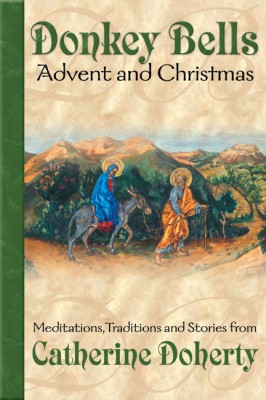One of my favorite Advent books and one that I read every year at this time is a book by Catherine Doherty called Donkey Bells: Advent and Christmas, published by Madonna House Publications. I love to read this inspiring book curled up in a comfortable chair by the wood stove, a hot chocolate or apple cider beside me, Advent and Christmas music playing quietly in the background.
This lovely book is filled with heartwarming stories, customs and traditions (such as the Advent wreath, baking, the blessing of the Christmas tree) and moving reflections for the season. It is a beautiful way for children, teens, and adults to prepare their hearts for Christmas.
The following is a story from Donkey Bells: Advent and Christmas by Catherine Doherty.
"Donkey Bells," by Catherine Doherty
(Creative Commons Licence Pass It On by Madonna House Publications is free to re-publish under a Creative Commons Attribution-NoDerivs 2.5 Canada License.)
It came to me, during these days of Advent, that I should share with you a custom which is not necessarily liturgical but which adds to the enjoyment of this lovely season. It has deep spiritual connotations; at least it did for our family, and for many others I knew when I was a young child.
When I was a little girl, my mother used to tell me that if I was good during this holy season of Advent, and offered my little acts of charity and obedience throughout Advent to the little Christ Child for a gift on his birthday, then sometime during Advent, at first very faintly and then quite clearly, I would hear bells. As she put it, the first church bells.
These were the bells around the neck of the little donkey that carried Our Lady. For mother explained that Our Lady carried Our Lord. She was the temple of the Holy Spirit, the first ‘church’ as it were, since Christ reposed in her. And the donkey, carrying Our Lady and sounding his bells as he walked, wore the first church bells.
Around the second week of Advent, mother wore a little bracelet that had tinkling bells. As she moved her hand I could hear them tinkle, and I got excited because I associated them with the donkey’s bells.
As young as I was, my imagination would build up a lot of little stories about the trip of Our Lady from Nazareth to Bethlehem — stories which I would share with my mother, and which would spur me on to further good deeds and little sacrifices.
During the third week of Advent, mother’s bracelet miraculously got many more bells on it. The sound grew louder and louder as Christmas approached. It was wonderful.
My brother and I used to listen. Mother’s bells were first around her wrist and then around her knee too. Then more bells, as it got closer to Christmas. We were really excited about them.
I introduced this little custom in Madonna House. During Advent, I wear a kind of bracelet that can be heard as I walk or move, in whatever room of the house I may be. The members of our family tell me that it spurs them on, even as it did me when I was a child, to meditate more profoundly on the mystery of Advent.
Here at Madonna House, we have begun in these last few years to make a collection of miniature donkeys — of wood, glass, ceramics, rope — you name it. And we have an album of Christmas cards (which we save from the many we receive) that depict the donkey in the manger scene.
The presence of the donkey and the ox in Scripture is symbolic of the prophets who foretold the Incarnation. And also of the fact that “the ox and ass know their Master’s voice, but Israel doesn’t know the voice of God” (Isaiah 1:3). So, you see, there is some spiritual foundation for my love for the donkey which brings such great joy to my heart.
I’m sure that, as a child, Christ rode on a donkey many times. And also as a man, of course. In Scripture we know of only two times: one was when the donkey carried Our Lady, who in turn carried God, from Nazareth to Bethlehem. The other was when the donkey carried Christ into Jerusalem as the people laid palm branches before Him, proclaiming him king.
Let us think for a moment: What kind of animal is a donkey? It is a beast of burden, the animal of the poor. Once again, the immense theme of poverty is illustrated in an animal. God chose the humblest, the smallest in status, because among the animals the donkey is considered very low. So God is teaching us a lesson here — a lesson of humility, of poverty, and of simplicity.
Have you ever seen a newborn donkey? Well, every donkey has a black cross on its gray fur, a marking which is especially noticeable just after it is born from its mother’s womb. It gets less clear as the donkey matures, but still is visible. I share this fact with you to teach you to open your heart to the bells of the donkey that carried Our Lady and also God.
The breath of the donkey and the ox made the stable warm. So we meditate on several things at once: the poverty and humility of the donkey God chose, and which should be our poverty and humility; and the breath of our love, which should warm God in our neighbor constantly.
Let us remember that the donkey also had no room at the inn. Neither woman, nor man, nor donkey had a place at the inn. So they went to live in a poor stable that wasn’t too well prepared for animals, let alone as a decent habitation for human beings.
Now, another meditation comes to us. Think of the millions of people who are left homeless on our streets. Tragic is this situation. We, as apostles, must be very careful that we do not exclude anyone from the inn of our heart.
I pray that our heart, our soul, our ears will hear very clearly ‘the bells of the donkey,’ not only in Advent but throughout the year. For whoever who is pure of heart and childlike shall hear the bells of the donkey ring in their life.
(Creative Commons Licence Pass It On by Madonna House Publications is free to re-publish under a Creative Commons Attribution-NoDerivs 2.5 Canada License.)
Do you have a favorite Advent or Christmas story? Please feel free to share.
Be sure to check out our Book Notes archive.
Copyright 2013, Ellen Gable Hrkach
About the Author

Ellen Gable Hrkach
Ellen Gable Hrkach and her husband, James, have been certified NFP teachers since 1984. Ellen is also an award-winning, bestselling author of 13 books, an editor, publisher, and self-publishing book coach. Her newest book is Life From the Bottom Shelf. The mother of five adult sons and grandmother of three precious grandchildren, Ellen lives in Pakenham, Ontario with her husband. Contact her at Full Quiver Publishing.




.png?width=1806&height=731&name=CatholicMom_hcfm_logo1_pos_871c_2728c%20(002).png)
Comments